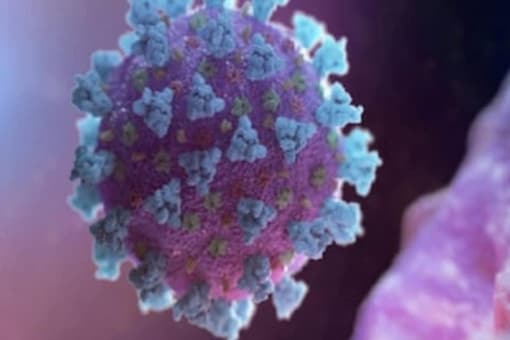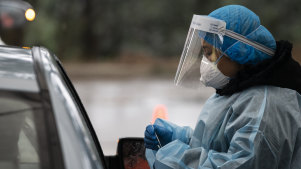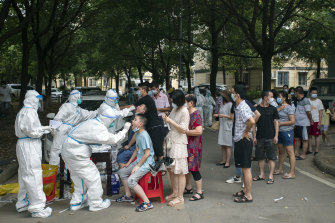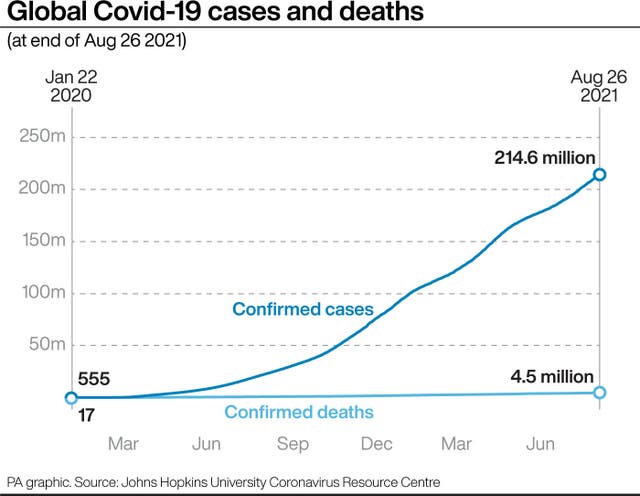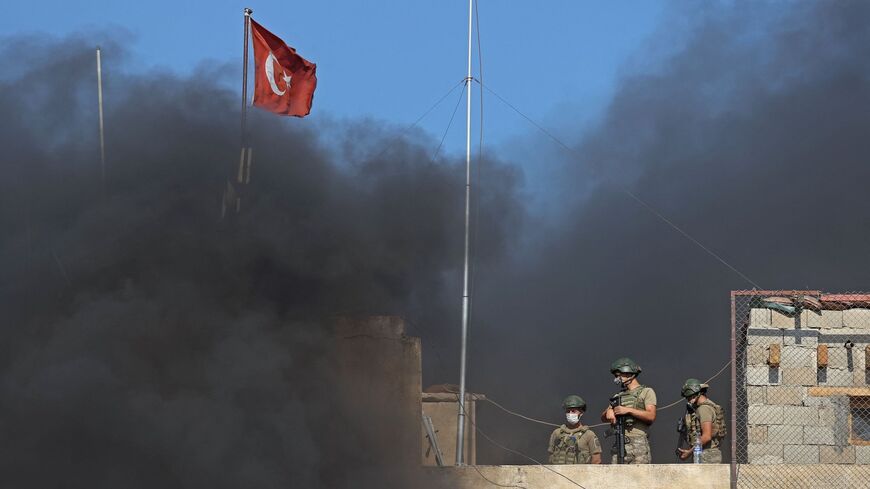Chase Lawrence, Barry Grey
an hour ago
WSWS
On Thursday night, the US Supreme Court overturned the national moratorium on evictions of renters put in place as a pandemic relief measure. The six-to-three ruling, with the right-wing bloc solidly aligned against the nominally liberal minority, upheld an emergency petition brought by realtors’ groups in Alabama and Georgia to terminate an extension of the eviction ban enacted by the Centers for Disease Control and Prevention (CDC) early this month following the July 31 expiration of a prior ban.
People from a coalition of housing justice groups hold signs protesting evictions during a news conference outside the Statehouse, July 30, 2021, in Boston. (AP Photo/Michael Dwyer)
The right-wing majority on the court had already signaled its intention to terminate the eviction ban, which, in any event, was slated to expire on October 3. Under conditions of an out-of-control pandemic, surging housing costs and consumer prices, and the expiration of federal unemployment benefits set for early September, the ruling by the unelected court marks a dramatic escalation of the class war policies being pursued by the corporate-financial oligarchy and all of its official institutions and parties.
The Center on Budget and Policy Priorities estimates that the number of adults living in households that are behind on their rent could exceed 11 million.
According to data from a Census Bureau survey, 6 percent of renters nationwide—more than 3.5 million people—say they are unable to pay their full rent due to the pandemic and are “likely” or “very likely” to face eviction. In several Southern and Midwestern states, including Missouri, North Carolina and Louisiana, almost one in five renters say they are worried about getting evicted.
The Wall Street Journal bluntly summed up the situation in an article headlined, “Renters Prepare for Eviction After Supreme Court Ruling.” It explained that landlords, with the exception of those in a handful of states and cities that have their own restrictions, can immediately go to court to obtain evictions for unpaid rent. In most courts, delayed eviction cases will now go forward. In others, already approved evictions will now be carried out by marshals and sheriffs.
The savagery of the ruling was underlined by its being carried out under an expedited “shadow docket” procedure that omits oral hearings, does not require signed opinions and, in general, curtails standards generally associated with due process.
The majority opinion, unsigned, declared that the CDC was overreaching its legal powers by ordering the eviction ban on public health grounds, citing the increased risk of COVID-19 infections and deaths resulting from a surge in homelessness. The ruling said the moratorium could not be maintained without congressional action.
The dissent, authored by Justice Stephen Breyer, denounced the use of the “shadow docket” procedure to decide such a socially consequential matter and cited the explosive spread of the pandemic with the proliferation of the Delta variant. He essentially argued that it was an inopportune time to terminate the eviction ban, writing: “The public interest strongly favors respecting the CDC’s judgment at this moment, when over 90 percent of counties are experiencing high transmission rates.”
The Biden White House, which had been prepared to accept the expiration of the eviction ban at the end of July and has made clear it will not seek to extend the federal unemployment benefit, signaled that it would not fight the court ruling. It and the Democratic Party are focused on forcing millions of unvaccinated children and hundreds of thousands of teachers into unsafe schools, even as infections and deaths hit new highs, rising most rapidly among school-age children.
White House Press Secretary Jen Psaki told reporters on Thursday that the administration would not seek to pass legislation to block evictions, and instead would seek to facilitate the distribution of $46.5 billion that had previously been appropriated to aid distressed renters and homeowners. The Treasury Department reported on Wednesday that only some $5.1 billion of this money had actually been disbursed by states and localities as of the end of July. Entire states, including New York, have not distributed a penny in renter relief funds.
House Speaker Nancy Pelosi similarly said the Democratic-controlled House of Representatives would seek to expedite the flow of rental-aid funds and said nothing about reinstituting a halt to evictions.
Even were the entire amount allocated to be immediately disbursed, it would be a drop in the bucket compared to the depth of the housing crisis. Responding to the court ruling, President and CEO of the National Low Income Housing Coalition (NLIHC) Diane Yentel said the result would be “millions of people losing their homes this fall and winter, just as the Delta variant ravages communities and lives.” She added that “evictions further burden overstretched hospital systems and make it much more difficult for the country to contain the virus. Evictions have been shown to increase the spread of, and potentially deaths from, COVID-19.”
According to an NLIHC report released in July, titled “Out of Reach 2021: The High Cost of Housing,” in “no state, metropolitan area, or county can a full-time minimum-wage worker afford a modest two-bedroom rental home, and these workers cannot afford modest one-bedroom apartments in 93 percent of US counties.” The report continues: “Over 7.5 million extremely low-income renters are severely housing cost-burdened, spending more than half of their incomes on housing.”
“More than 226,000 people in the US experienced homelessness on sidewalks or other unsheltered locations on a given night in 2020,” the report notes, “and another 354,000 experienced homelessness in emergency shelters, with limited ability to self-isolate. In addition, more than 2.7 million renters live in overcrowded housing conditions.”
Another NLIHC report issued in July states that many who have remained caught up on rent “may have done so by unsustainable means,” such as “using credits cards or loans, selling assets or drawing down savings, or borrowing from friends and family…” Of those who had fallen behind in rent, a majority reported delaying bills and cutting back on food, while more than a quarter had forgone medical care.
Moreover, in much of the country, evictions continued even before the ending of the moratorium, which was poorly enforced and frequently defied by right-wing judges. The Princeton University Eviction Lab reported over 6,500 evictions last week in the six states and 31 cities it tracks. Since March 2020, 480,000 eviction cases have been filed. Some cities are already up to or above pre-pandemic levels of evictions, including Las Vegas, Nevada and Gainesville, Florida.
John Jopling, director of housing law at the nonprofit Mississippi Center for Justice, told the Washington Post, “You hear a lot of people talk about this cliff that we’re headed for as far as evictions, but really, I think, it’s more of a rolling tide—and we’re already in the middle of it.
“These tenants, they’re going to wind up in cars, they’re going to wind up on top of relatives, which is not what they need to be doing especially now in intergenerational households with all the variants of COVID that are spreading out there. They’re going to wind up on top of elderly relatives because of that immediate removal.”
The social and economic interests that dictate government policy were underscored by the concurrence of the Supreme Court attack on hard-pressed working-class families and the speech delivered the following morning by Federal Reserve Chairman Jerome Powell. Giving the keynote address at the annual Jackson Hole, Wyoming meeting of Fed officials and world central bankers, Powell reassured Wall Street that the flood of money into the financial markets by means of zero interest rates would continue indefinitely, and any tapering of quantitative easing purchases of financial assets—currently at the rate of $120 billion every month —would be carried out slowly, despite the highest rates of US inflation in 30 years.
The result was a further surge in stock prices, with the Nasdaq and S&P 500 indexes closing at new record highs.
MARYLAND
Advocates Call For State, Federal Action After Supreme Court Blocks CDC Eviction Protections

Local leaders and advocates are calling for state and congressional action on evictions after the U.S. Supreme Court blocked federal protections for tenants Thursday.
The Centers for Disease Control and Prevention (CDC) issued limited eviction protections based on COVID-19 transmission levels earlier this month after more sweeping protections expired at the end of July. President Biden acknowledged at the time that the emergency protections would be “likely to face obstacles,” since the Supreme Court had previously indicated that Congress would need to pass any future protections.
Those protections essentially allowed tenants an affirmative defense in certain types of eviction cases including failure to pay rent. Fair housing advocates have cautioned against characterizing the order as a “moratorium,” since it requires tenants to show up to court and successfully raise the affirmative defense to temporarily avert an eviction.
Similar state-level protections from Gov. Lawrence J. Hogan Jr. (R) phased out earlier this month. Those protections also provided tenants with an affirmative defense. Local leaders have urged Hogan to reinstate those protections in recent weeks, to no avail.
“Baltimore has millions of dollars coming to us from the state and federal governments to help renters pay their rent. We need more time and tools to distribute the funds. This resolution calls on Governor Hogan to do the right thing,” Baltimore City Councilmember Odette Ramos (D), the lead sponsor of a resolution calling on Hogan to extend state protections, said in a statement earlier this month.
In an unsigned majority opinion issued Thursday, justices argued that the CDC didn’t have the authority to take such sweeping action.
“It would be one thing if Congress had specifically authorized the action that the CDC has taken,” the opinion reads. “But that has not happened. Instead, the CDC has imposed a nationwide moratorium on evictions in reliance on a decades-old statute that authorizes it to implement measures like fumigation and pest extermination. It strains credulity to believe that this statute grants the CDC the sweeping authority that it asserts.”
The court’s liberal justices, Stephen Breyer, Sonia Sotomayor and Elena Kagan, dissented. The trio wrote that the CDC’s more granular protections, which vary based on local transmission rates, are within the health agency’s purview.
“The public interest is not favored by the spread of disease or a court’s second-guessing of the CDC’s judgment,” the justices wrote in their dissenting opinion. “The CDC has determined that ‘[a] surge in evictions could lead to the immediate and significant movement of large numbers of persons from lower density to higher density housing. . . when the highly transmissible Delta variant is driving COVID–19 cases at an unprecedented rate.’”
Some members of Maryland’s congressional delegation pledged to take action on evictions when Congress returns. Congressman Anthony G. Brown (D-Md.) said he would vote to extend the federal eviction protections, and also urged Hogan to extend state protections.
“I stand ready to vote to extend the federal eviction moratorium and call on my Republican colleagues to end their opposition and put the needs of American families first,” Brown said in a statement. “I urge Governor Hogan to immediately extend our state’s now expired moratorium on evictions to protect working families and reiterate my call for state and local leaders to expedite the disbursement of federal funding through the American Rescue Plan’s Emergency Rental Assistance program to support Marylanders in need. What we do in the next several weeks can mean the difference in families’ lives.”
Sen. Chris Van Hollen (D-Md.) likewise said in a statement that Congress should extend the eviction protects.
“The Supreme Court’s decision to end the eviction moratorium puts thousands of Marylanders at risk of losing the roofs over their heads, but it’s also unacceptable that only a small share of the $753 million in federal funds for Maryland COVID-19 emergency rent payments have been used to help keep folks in their homes,” he said. “Federal, state, and local officials must cut the red tape and distribute these funds promptly so renters can stay in their homes and landlords can pay their own bills. In the meantime, as the Delta variant continues to spread, Congress should take action to extend the eviction moratorium.”
Efforts by congressional Democrats to extend the eviction protections previously fell short before they recessed for August.
Uncertainty for tenants
Fair housing advocates have long warned that, despite the now-expired federal and state protections, tenants have been facing eviction throughout the pandemic. There are roughly 129,000 households behind on rent in Maryland, according to the National Equity Atlas. An estimated 78% of the households are people of color, 62% have an income of less than $50,000 per year, and 42% are unemployed.
The end of federal and state eviction protections mean that Maryland courts will begin moving forward with judgements that have been reserved in cases where tenants have successfully raised those affirmative defenses. Maryland District Court Chief Judge John P. Morrissey said in an Aug. 4 communication that “cases where a reserved judgment was entered as a judgment for possession between August 1, 2021 and August 3, 2021, are stayed for as long as those counties are subject to the new CDC agency order.” With both state and federal protections now ended, the court will begin processing reserved judgements.
State and federal elected officials, alongside advocacy groups for tenants and landlords alike, have called on local governments to quickly distribute rent relief funding. Local jurisdictions have been tasked with distributing federal relief funding throughout the pandemic, but some local officials say red tape and cumbersome applications mean that rent relief has been slow to get out the door.
“The federal government managed to create guidelines that make it harder to get money out, even though they gave us the money,” Montgomery County Executive Marc B. Elrich (D) previously told Maryland Matters. “It still wasn’t like we could just use our existing programs and keep pushing money out through the windows or programs we already had. We had to reconfigure this.”
Jurisdictions’ approach to distributing rent relief varies. In addition to individual applications, some local governments have partnered with United Way to work with landlords and bundle large number of eligible tenants together in an effort to streamline rent relief. That program started in Baltimore County, but recently expanded to include other jurisdictions.
Elrich and other local leaders asked Hogan in May to institute a 90-120 day moratorium on all evictions to give them more time to get rent relief funding to tenants and landlords, but no such order was put in place. The Biden administration has recently ramped up efforts to speed up rent relief distribution, including more lenient treasury guidance issued earlier this week.
Court backlogs due to prior pandemic-related closures could mean that newly filed eviction cases take months until they’re heard, Adam Skolnik, the executive director of the Maryland Multi-Housing Association, said. While some fair housing advocates worry that courts will try to rapidly work through that backlog, Skolnik said the delays practically amount to a “de facto moratorium.”
He added that loosened Treasury Department guidance and allowing local governments for flexibility in distributing rent relief will be “hugely important” in preventing evictions.
Ramos said even one eviction caused by the pandemic or a pandemic-related loss of income is one too many.
“We’re not seeing a mass of evictions because the courts are slow, but we are still seeing evictions,” Ramos said.
She added that she wants to see rental assistance reaching tenants and landlords before the eviction process begins.
“We want to make sure that everybody who is having a COVID impact is helped, and landlords are part of that,” Ramos said. “That’s why we need more time to be able to get rental assistance out the door.”
Zafar Shah, an attorney with the Public Justice Center, said many local protections for tenants are “dwindling” because they were tied to the statewide catastrophic health emergency or state of emergency. He also noted that local jurisdictions don’t have the authority to institute their own eviction moratoriums.
Tenants would have received additional protections that would’ve lasted for months after Maryland’s catastrophic health emergency expired under legislation from Del. Jheanelle K. Wilkins (D-Montgomery), but that proposal failed to pass before the end of the 2021 legislative session earlier this year.
“We could have acted to put policy in place to ensure that policy protections and law would be there at this critical moment for residents,” Wilkins previously said. “We wouldn’t have to depend on Congress and the president and the governor. We had the opportunity during session to … put this in place, and it stalled in the Senate and that’s very disappointing.”
Advocates call for special session
In addition to calling for congressional action and for Hogan to extend state protections, some tenant advocates said Friday that the General Assembly should call a special session to address eviction prevention and rent relief. Legislative leaders are already tentatively planning a special session in December to handle congressional redistricting.
“This doesn’t have to happen,” a Friday statement from Baltimore Renters United and Renters United Maryland reads. “Congress can extend the CDC Order. Governor Hogan can issue an order that pauses evictions when a rental assistance application has been filed. The General Assembly can call a special session and do the same.”
Baltimore Renters United and Renters United Maryland also urged lawmakers to fund the access to counsel initiative passed by the General Assembly earlier this year. A bill that would have raised certain surcharges and court filing fees to pay for that access to counsel failed to pass before the end of the 2021 legislative session.
Shah said he believes a special session on housing would be “warranted.” He said he has little confidence that Congress will act on eviction protections. He also warned that waiting until December or January to act in Maryland could lead to a surge of evictions. He said that, according to district court data, more than 40,000 eviction cases were filed in July.
Shah said it’s important to not only extend eviction protections for tenants, but foreclosure protections for homeowners as well. The state is facing “twin trains” of eviction and foreclosure happening at the same time,” he said.
“We really do need Annapolis to act, to respond,” Shah said. “That’s what everyone expects right now.”
August 27, 2021
Millions of Americans are at risk of eviction and homelessness after the Supreme Court blocked the Biden administration's eviction ban extension on Thursday.
The court issued an unsigned eight-page opinion saying the Centers for Disease Control and Prevention exceeded their authority by issuing an eviction moratorium extension, which was aimed at areas with "substantial" COVID spread.
"It would be one thing if Congress had specifically authorized the action that the CDC has taken. But that has not happened," the opinion said. "Instead, the CDC has imposed a nationwide moratorium on evictions in reliance on a decades-old statute that authorizes it to implement measures like fumigation and pest extermination. It strains credulity to believe that this statute grants the CDC the sweeping authority that it asserts."
The court said "if a federally imposed eviction moratorium is to continue, Congress must specifically authorize it."
The court's three liberals dissented.
"The CDC targets only those people who have nowhere else to live, in areas with dangerous levels of community transmission," Justice Stephen Breyer wrote in a dissent joined by Justices Sonia Sotomayor and Elena Kagan. "These people may end up with relatives, in shelters, or seeking beds in other congregant facilities where the doubly contagious Delta variant threatens to spread quickly."
The opinion was part of the court's "shadow docket," where the justices hand down largely unsigned short opinions without going through standard hearings, deliberations, and transparency. Such cases had been mostly limited to uncontroversial petitions or rare emergencies but the shadow docket has dramatically grown under the increasingly conservative Supreme Court, alarming legal experts. "If (the justices) can make significant decisions without giving any reasons, then there's really no limit to what they can do," David Cole, the legal director of the American Civil Liberties Union, told Reuters.
Breyer in his dissent argued that the questions about the eviction moratorium were too big for the shadow docket.
"These questions call for considered decisionmaking, informed by full briefing and argument," he wrote. "Their answers impact the health of millions. We should not set aside the CDC's eviction moratorium in this summary proceeding. The criteria for granting the emergency application are not met."
The court's ruling effectively allows eviction proceedings to resume, putting more than 7 million Americans who have fallen behind on rent at risk.
The Trump administration first issued the ban last September after Congress failed to extend the moratorium included in the first round of pandemic relief. The Supreme Court allowed the moratorium to continue in June after conservative Justice Brett Kavanaugh, the deciding fifth vote, said the CDC likely exceeded its authority but let the ban stay because it was set to expire last month. The Biden administration planned to let the ban expire before calling on Congress to extend it amid pressure from lawmakers. House moderates ultimately killed a last-minute effort to pass an eviction ban, which would have been doomed in the Senate regardless, prompting the CDC to issue a revised extension more tailored to areas hardest hit by COVID. Biden acknowledged at the time that the extension may not hold up but "by the time it gets litigated, it will probably give some additional time while we're getting that $45 billion out to people who are, in fact, behind in the rent and don't have the money."
But the distribution of rental assistance has been woefully slow. Congress approved $46 billion in rental aid since December but just $5.1 billion was distributed through July, according to the Treasury Department. With only 11% of the funds distributed, the federal government has tried to pressure state and local officials to move faster and issued new rules to make it easier for applicants to seek aid. But many state and local governments have struggled to set up a system to distribute the funds and some landlords have balked at accepting the aid because it requires them to agree not to evict the tenant for another year.
The eviction ban has provided a lifeline to struggling families since the pandemic began.
"Over the last 11 months, while this eviction moratorium has been in place, we estimate that there have been at least 1.5 million fewer eviction cases than normal," Peter Hepburn of the Princeton University Eviction Lab told NPR. "This has really helped to keep an extraordinary number of families in their homes."
The Biden administration said it is "disappointed" in the Supreme Court's ruling.
"As a result of this ruling, families will face the painful impact of evictions, and communities across the country will face greater risk of exposure to COVID-19," White House press secretary Jen Psaki said.
Rep. Cori Bush, D-Mo., who slept on the Capitol steps earlier this month to protest the expiration of the earlier moratorium, said the court "failed to protect" millions of people from "violent eviction in the middle of a global pandemic" and again called on Congress to act.
"We already know who is going to bear the brunt of this disastrous decision," she said, "Black and brown communities, and especially Black women."
Updated: 2:21 p.m. | Published: 2:17 p.m.

In this Aug. 4, 2021, file photo, housing advocates protest evictions in New York. The Supreme Court is allowing evictions to resume across the United States, blocking the Biden administration from enforcing a temporary ban that was put in place because of the coronavirus pandemic.
By Sabrina Eaton, cleveland.com
WASHINGTON, D.C. - Advocates of halting evictions during the coronavirus pandemic said they were disappointed by the U.S. Supreme Court’s Thursday night ruling that overturned an Aug. 3 Centers for Disease Control moratorium on evictions for tenants in parts of the country with substantial or high levels of COVID–19 transmission.
The CDC action had continued a moratorium that expired on July 31. It was issued after a U.S. Supreme Court opinion from Justice Brett Kavanaugh said Congress would have to act to extend the old moratorium. Thursday’s ruling said Congress did not authorize the CDC’s action, and said it put millions of landlords around the country “at risk of irreparable harm by depriving them of rent payments with no guarantee of eventual recovery.”
“Despite the CDC’s determination that landlords should bear a significant financial cost of the pandemic, many landlords have modest means. And preventing them from evicting tenants who breach their leases intrudes on one of the most fundamental elements of property ownership—the right to exclude,” the ruling said.
When the moratorium extension was issued, federal authorities said it would provide more time for $47 billion in emergency rental assistance that was allotted in coronavirus relief bills to reach those who need it, and give more people a chance to get vaccinated. A fact sheet the White House released Wednesday said state and local agencies have spent more than $5.1 billion in Emergency Rental Assistance funds to help households at-risk of eviction.
A joint statement from the The Coalition on Homelessness and Housing in Ohio (COHHIO) and the Ohio Poverty Law Center (OPLC) said the moratorium provided tenants with more time to apply for federal Emergency Rental Assistance, and without it, more families could get evicted while waiting for their applications to be processed. Emergency Rental Assistance can cover up to 12 months of rent and utilities arrears and three months forward for tenants affected by the pandemic.
The statement noted that Ohio Chief Justice Maureen O’Connor recently sent a letter to local judges recommending they help tenants and landlords access Emergency Rental Assistance to prevent evictions for nonpayment of rent, and urged judges to delay individual eviction cases until the applications are processed. It said eviction filings in Ohio dropped when the pandemic first took hold in 2020, but have since risen to roughly 65 percent of pre-pandemic levels.
“We shouldn’t rush to evict, especially now that assistance is available and the delta variant is spreading so rapidly in Ohio,” said a statement from OPLC attorney Graham Bowman.
A statement from Housing and Urban Development Secretary Marcia Fudge said the Supreme Court’s decision put millions of Americans at risk of losing their homes while the delta variant heightens risk of exposure to COVID-19. Fudge’s statement said many of the Americans at risk for eviction include senior citizens, people with chronic illnesses, young children and families with the lowest incomes.
“I pledge that the Department of Housing and Urban Development will continue to use every tool at our disposal to protect those people whose health and well-being are now in jeopardy,” said Fudge, a former U.S. Congress member from Warrensville Heights. “We can help preserve the safety and security of millions of Americans if we act with urgency—and with compassion in the midst of crisis. HUD is determined to do our part. We call on others to do their part as well.”
A statement from U.S. Sen. Sherrod Brown, an Ohio Democrat, called the decision “shameful, especially when the troubling rise of the delta variant means families need protection now more than ever.
“It is vital that state and local governments join us in preventing evictions, including connecting renters with the assistance we passed so that families can stay in their homes as we work to put this public health crisis behind us,” Brown’s statement continued.
Republicans said they weren’t surprised by the decision and urged Democratic House Speaker Nancy Pelosi to take bipartisan action to help renters and property owners across the country.
“This was entirely avoidable, especially if the Administration properly managed and ensured the rental assistance Congress had already passed was sent to people who needed it,” said a statement from the top Republican on the House Energy and Commerce Committee, Washington’s Cathy McMorris Rodgers.
A letter Pelosi sent to congressional Democrats on Friday called the court’s decision “immoral” and “a serious public health threat” as the delta variant continues to spread. The letter pledged to keep working with the Biden administration and communities to halt evictions and ensure disbursement of rental assistance designed to stop evictions, and said new Treasury Department guidance to state and local grantees will speed up the flow of money to those in need.
“Families must be protected during the pandemic, and we will explore every possible solution,” said the letter, which said the House is assessing possible legislative remedies.
Issued on: 27/08/2021 -

Washington (AFP)
The US Supreme Court on Thursday blocked the extension of a federal moratorium on evictions, ending a protection granted to millions who have struggled to afford rent during the Covid-19 pandemic.
In a 6-3 ruling, the court sided with homeowners who claimed to be victims of unwarranted measures, and argued that any renewal of a moratorium must be decided by Congress and not health officials.
The court's unsigned majority opinion said the Centers for Disease Control and Prevention (CDC) had exceeded its authority with its latest order temporarily halting evictions in areas where coronavirus cases were surging.
"It is up to Congress, not the CDC, to decide whether the public interest merits further action here," read the eight-page majority opinion.
The court's three liberal justices dissented, citing fears that evictions could exacerbate the spread of the Delta variant.
The case was prompted by the CDC's latest, two-month-long moratorium, rolled out on August 3.
An earlier, September 2020 moratorium issued by the CDC expired after a Supreme Court ruling in June said it could not continue beyond July 31 without authorization from Congress.
President Joe Biden's administration had urged Congress to approve an extension, but US lawmakers failed to do so before summer recess.
Under pressure from Democrats, the CDC ordered a new moratorium, citing public health risks posed by the pandemic.
The Supreme Court has now ended that moratorium.
At the White House, Press Secretary Jen Psaki said the administration "is disappointed" that the court blocked the eviction moratorium "while confirmed cases of the Delta variant are significant across the country".
The moratorium "saved lives by preventing the spread of the Covid-19 virus throughout the pandemic," Psaki said in a statement.
The White House had expected the moratorium to be challenged in court, but hoped the extra time would allow for emergency rental assistance funds approved by Congress to reach those in need.
But much of that money is still caught in red tape, even as around 3.5 million people in the US told the Census Bureau they face eviction in the next two months.
In light of the ruling "and the continued risk of Covid-19 transmission, President Biden is once again calling on all entities that can prevent evictions... to urgently act to prevent evictions," Psaki said.
© 2021 AFP
Democrats attack Supreme Court for blocking Biden eviction moratorium
NYC Mayor Bill de Blasio attacked the Supreme Court as a 'group of right-wing extremists'
Democrats are lashing out at the Supreme Court for blocking President Biden's eviction moratorium.
"If a federally imposed eviction moratorium is to continue," the ruling said about the moratorium Biden imposed as a means of protecting renters financially affected by the coronavirus, "Congress must specifically authorize it."
DEMOCRATS RENEW PUSH TO PACK SUPREME COURT
Democrats quickly mobilized to delegitimize the court's ruling.
House Democratic Caucus Chair Hakeem Jeffries claimed the "Supreme Court does not have a scintilla of credibility" after the decision.
New York City Mayor Bill de Blasio attacked the Supreme Court as a "group of right-wing extremists" that ruled to "throw families out of their homes during a global pandemic."
"This is an attack on working people across our country and city," de Blasio tweeted Thursday. "New York won’t stand for this vile, unjust decision."
"Squad" member Rep. Cori Bush, D-Mo., claimed that if the Supreme Court "thinks this partisan ruling is going to stop us from fighting to keep people housed, they’re wrong."
Rep. Mondaire Jones, D-N.Y., used the ruling to push the far-left idea of packing the Supreme Court.
Justices Sonia Sotomayor, Elena Kagan and Stephen Breyer — the three liberal justices on the Supreme Court — dissented with the conservative majority’s ruling.
This marks the Biden administration’s second judicial defeat in the Supreme Court this week, after the body effectively reinstated former President Trump’s "Remain in Mexico" immigration policy for asylum seekers awaiting their hearings.
Andrew Mark Miller contributed reporting

BYJake Johnson, Common DreamsPUBLISHEDAugust 27, 2021
Millions of people across the U.S. are once again at imminent risk of losing their homes after the conservative-dominated Supreme Court on Thursday struck down the Biden administration’s eviction moratorium, siding with a coalition of landlords and real estate companies that challenged the critical lifeline.
In an unsigned opinion, the 6-3 conservative majority ruled (pdf) that the Centers for Disease Control and Prevention does not have the authority to implement the eviction moratorium, the latest version of which was put in place earlier this month in response to pressure from progressive lawmakers and activists.
Writing for the three dissenting liberal justices, Stephen Breyer slammed the high court’s conservatives for rushing their massively consequential decision on the eviction ban without a “full briefing and argument.” The moratorium on evictions for non-payment of rent was originally intended to run through October 3.
“The public interest strongly favors respecting the CDC’s judgment at this moment, when over 90% of counties are experiencing high [coronavirus] transmission rates,” Breyer wrote, noting that the real estate coalition’s earlier argument against the eviction moratorium — that Covid-19 infections were trending downward — no longer holds.
The high court’s ruling came just a day after the U.S. Treasury Department released figures showing that 89% of rental assistance funds approved by Congress have not yet been distributed — a problem that some critics have attributed to the faulty design of the federal aid program.
Housing experts and advocates estimate that total rental debt in the U.S. currently amounts to around $21.3 billion, with households that are behind on rent owing $3,300 on average.
Congress has approved $46.5 billion in emergency rental assistance.
In a statement late Thursday, Rep. Cori Bush (D-Mo.) called the Supreme Court’s ruling “disastrous” and said that “Congress must act immediately to prevent mass evictions.”
Earlier this month, Bush and other progressive lawmakers camped out on the steps of the U.S. Capitol building to protest the expiration of a previous CDC eviction moratorium. Days after the demonstration began, the CDC authorized a new eviction ban that covered around 90% of the country.
“We are in an unprecedented and ongoing crisis that demands compassionate solutions that center the needs of the people and communities most in need of our help,” Bush said Thursday. “We didn’t sleep on those steps just to give up now… I urge my colleagues to reflect on the humanity of every single one of their unhoused, or soon-to-be unhoused, neighbors, and support a legislative solution to this eviction crisis.”
While some cities and states still have moratoria in place, the Supreme Court’s decision means that millions of renters who are behind on payments are set to lose their last remaining protections, setting the stage for a wave of evictions as coronavirus infections surge across the country.
“This is cruel and wrong,” tweeted Rep. Pramila Jayapal (D-Wash.), chair of the Congressional Progressive Caucus. “If the public health crisis hasn’t ended, then the relief to survive it shouldn’t either. We must immediately do everything possible to keep people in their homes. This is a matter of life and death.”
According to a recent analysis by Eviction Lab, U.S. neighborhoods with the highest eviction filing rates typically have the lowest levels of vaccination against Covid-19. In some Southern states, landlord-friendly laws and procedures allow evictions to be fast-tracked, meaning the consequences of the high court’s decision could be felt in the very near future.
Diane Yentel, president and CEO of the National Low Income Housing Coalition, warned that “the tragic, consequential, and entirely avoidable outcome of this ruling will be millions of people losing their homes this fall and winter, just as the Delta variant ravages communities and lives.”
“Evictions risk lives and drive families deeper into poverty,” said Yentel. “During a pandemic, evictions further burden overstretched hospital systems, and make it much more difficult for the country to contain the virus. Evictions have been shown to increase spread of, and potentially deaths from, Covid-19. For families and individuals, evictions are profoundly traumatizing and destabilizing. For the country, evictions are expensive. The tragic consequences of this decision will reverberate for years.”
It is not yet clear what specific steps the White House and Congress — which is currently on recess — intend to take in response to the Supreme Court’s ruling. In a statement, White House Press Secretary Jen Psaki said the Biden administration was “disappointed” by the decision and urged “all entities that can prevent evictions — from cities and states to local courts, landlords, cabinet agencies — to urgently act.”
Rep. Mark Pocan (D-Wis.), chair emeritus of the Congressional Progressive Caucus, argued late Thursday that “Congress should immediately come back into session and extend the moratorium.”
“The Supreme Court blocking the eviction moratorium while the pandemic is killing 1,000 people a day is appalling,” said Pocan.


